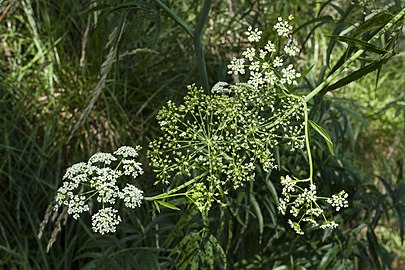bio.wikisort.org - Plant
Cicuta maculata is a highly poisonous species of flowering plant in the carrot family known by several common names, including spotted water hemlock, spotted parsley, spotted cowbane, and the suicide root by the Iroquois. It is native to nearly all of North America, from northern Canada to southern Mexico.
| Cicuta maculata | |
|---|---|
 | |
| Scientific classification | |
| Kingdom: | Plantae |
| Clade: | Tracheophytes |
| Clade: | Angiosperms |
| Clade: | Eudicots |
| Clade: | Asterids |
| Order: | Apiales |
| Family: | Apiaceae |
| Genus: | Cicuta |
| Species: | C. maculata |
| Binomial name | |
| Cicuta maculata | |
| Synonyms[1] | |
|
Cicuta bolanderi | |
Description
Cicuta maculata is a rhizomatous perennial herb producing a hollow erect stem that can reach a height of 1.8 meters (6 feet).[2] The long leaves are made up of several lance-shaped, pointed, serrated leaflets. Each shiny green leaflet is 2 to 10 centimeters (1 to 4 inches) long and the entire leaf may be up to 40 cm (16 in) long. The inflorescence of white flowers is similar in appearance to other species in the carrot family. It is a compound umbel with many clusters of flowers. The dry tan-brown fruit is a few millimeters long.
The plant prefers wet habitats, such as wet meadows, roadside ditches, pond margins, open marshes, and freshwater swamps.[3][4][5] Flowering is from May to September.[5]
The poisonous plant is occasionally mistaken for parsnips, due to its clusters of white tuberous roots.
Toxicity
The confusion with parsnips can be fatal as C. maculata is extremely poisonous. It is considered to be North America's most toxic plant.[6][7][8]
Cicuta is fatal when swallowed, causing violent and painful convulsions. Though a number of people have died from water hemlock poisoning over the centuries, livestock have long been the worst affected (hence the name "cowbane"), with ingestion of the plant causing death in as little as 15 minutes.[9][10]
The chief poison is cicutoxin, an unsaturated aliphatic alcohol that is most concentrated in the roots. Upon human consumption, nausea, vomiting, and tremors occur within 30–60 minutes, followed by severe cramps, projectile vomiting, and convulsions. Occasional long-term effects include retrograde amnesia.[11] Ingestion of water hemlock in any quantity can result in death or permanent damage to the central nervous system.
See also
References
- "Cicuta maculata". Germplasm Resources Information Network (GRIN). Agricultural Research Service (ARS), United States Department of Agriculture (USDA). Retrieved 12 January 2018.
- The Complete Guide to Edible Wild Plants. United States Department of the Army. New York: Skyhorse Publishing. 2009. p. 143. ISBN 978-1-60239-692-0. OCLC 277203364.
{{cite book}}: CS1 maint: others (link) - "Cicuta maculata". iowaplants.com.
- "Lady Bird Johnson Wildflower Center - The University of Texas at Austin". www.wildflower.org.
- "Cicuta maculata page". www.missouriplants.com.
- Schep LJ, Slaughter RJ, Becket G, Beasley DM (April 2009). "Poisoning due to water hemlock". Clin Toxicol. 47 (4): 270–8. doi:10.1080/15563650902904332. PMID 19514873. S2CID 21855822.
- "ARS". usda.gov.
- 'Do not eat, touch, or even inhale the air around the Machineel Tree' (Atlas Obscura) Accessed 14 August 2019
- "Poison Plants (California Veterinary Association)". Archived from the original on 12 September 2007. Retrieved 10 July 2008.
- USDA Plants Profile
- Costanza, David J.; Hoversten, Vincent W. (1973). "Accidental Ingestion of Water Hemlock". Calif Med. 119 (2): 78–82. PMC 1455113. PMID 4726956.
External links
- Jepson Manual Treatment
- Photo gallery
- "Water Hemlock: Cicuta maculata". Illinois Wildflowers.
- Fertig, Walter. "Water Hemlock (Cicuta maculata or Cicuta maculata (DC.) J.M. Coult. & Rose)". U.S. Forest Service.
- "Cicuta maculata L.". Go Botany.
На других языках
- [en] Cicuta maculata
[ru] Cicuta maculata
Cicuta maculata (Вёх пятнистый) — ядовитый вид цветковых растений семейства Зонтичные (Umbelliferae), известных под несколькими распространенными названиями, в том числе «пятнистый водяной болот», «пятнистая петрушка», «пятнистый ковбой» и «корень самоубийства» у ирокезов. Вид произрастает почти по всей Северной Америке, от северной Канады до южной Мексики. Это корневищное многолетнее травянистое растение, дающее полый вертикальный стебель на максимальной высоте от 1 до 1,5 метров. Длинные листья состоят из нескольких заостренных зубчатых листочков. Каждая блестящая зелёная листовка имеет длину от 2 до 10 сантиметров, а длина всего листа может достигать 40 сантиметров. Соцветие — сложный зонтик из белых цветков, по внешнему виду сходно с другими видами семейства Зонтичные, особенно с пастернаком, что и приводит к фатальным последствиям для перепутавших. Яд — цикутоксин, концентрируется в корнях растения. Сухой жёлто-коричневый плод имеет длину несколько миллиметров.Другой контент может иметь иную лицензию. Перед использованием материалов сайта WikiSort.org внимательно изучите правила лицензирования конкретных элементов наполнения сайта.
WikiSort.org - проект по пересортировке и дополнению контента Википедии


